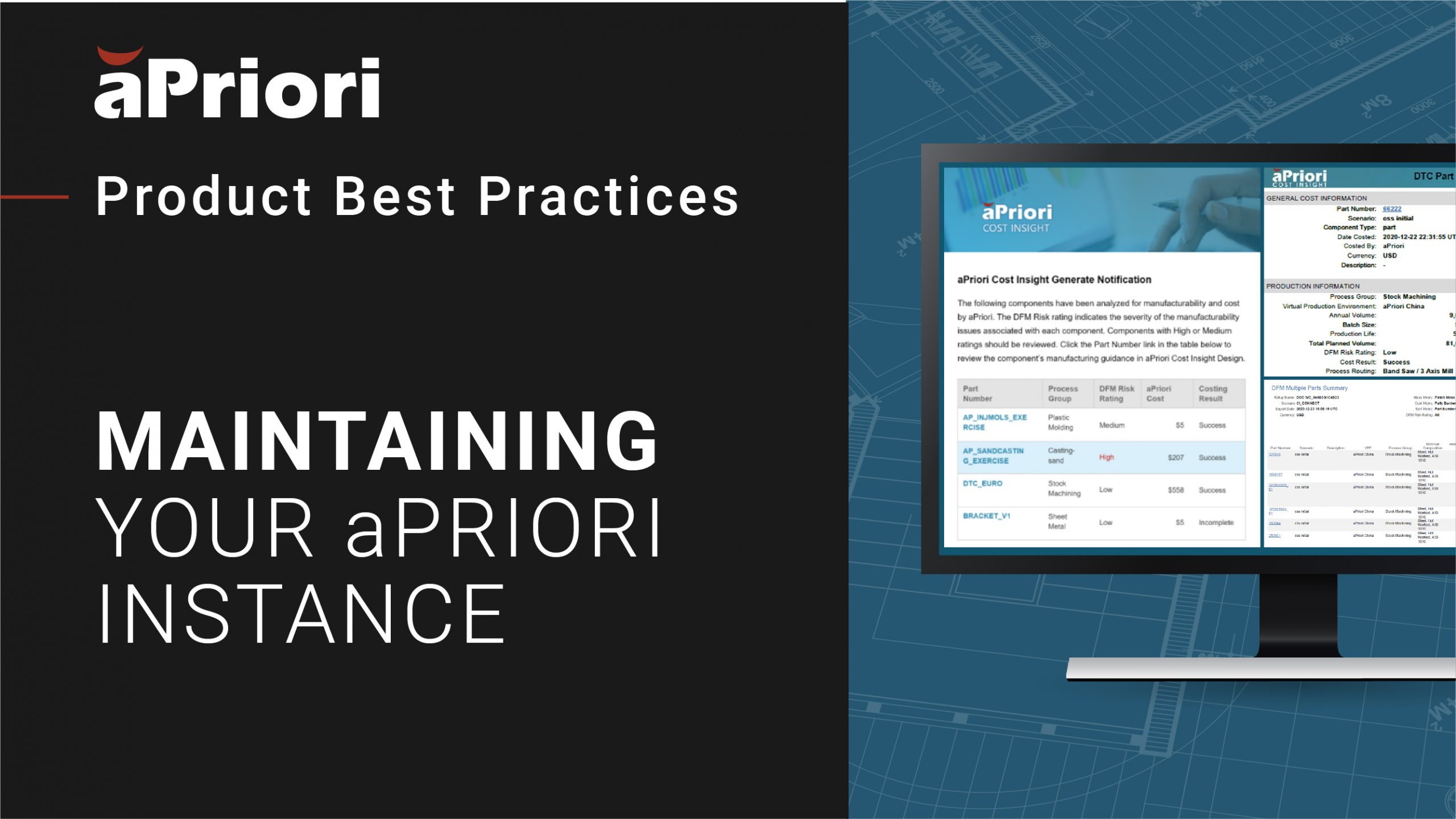Video
How to Keep Your aPriori Technology Up to Date
If your business decisions rely on aPriori, ensure that your instance is well-maintained to ensure that you always leverage the newest solutions and enhancements. This video highlights the key aspects of an aPriori solution that need to be part of your technology maintenance strategy as well as best practices to stay ahead of the game. You’ll learn about:
– aPriori’s new-product and data-release processes
– How to keep your aPriori cost models up to date
– How to access and update regional libraries
– Tips and tricks for aPriori maintenance and upgrades
– The basic playbook for long-term maintenance

Transcript
Hello everyone and welcome to our session, Keeping Your aPriori Solution up to Date. My name is Tobias Tauber, Enterprise Success Manager at aPriori, and I’m joined in this presentation by my colleague Cormac Eastwood, Expert Services Consultant at aPriori.
We would like to walk you through the following content. We’re gonna start with a quick overview on how aPriori works. What is the trick around maintenance? What’s the challenge around maintaining your aPriori solution? A line on the fundamentals of our solution that require maintenance, and then go into the section for proactive planning. And then at the end we’ll have an open session for Q&A.
aPriori Connects Your Entire Product Development Team
TT: How aPriori works, aPriori brings product design closer to production with design for manufacturability (DFM) and cost feedback. So it’s the only tool that brings design engineering, sourcing and procurement, manufacturing, and suppliers, real-time manufacturability information as well as product cost insights, using real-time automation.
This is made possible due to the intelligence created by our manufacturing simulations and stored in our digital factories. So if you look at this from different solution components, we do start from the digital twin, the the three-dimensional presentation of your part assembly product. Take this CAD model or CAD file, import it into aPriori, and translate it into what we call geometric cost drivers. In our simulation engine. There’s also another set of inputs that comes from the digital factories. They can be considered as digital twins of a manufacturing facility environment, group of suppliers, or internal facility. They store all the logic, the rules, the routing rules, the physical manufacturing capabilities, the manufacturing process, the machines, the material, as well as the regional accounting data. The simulation engine in the middle of aPriori takes the geometry inputs as well as the input logic from the digital factory and runs the simulations on manufacturability issues and cost.
aPriori’s common platform provides a shared architecture to allow everybody involved in the product lifecycle and even up to the supply chain to collaborate as the product design takes form. For your specific aPriori solution, and most crucial in this presentation today is the focus on the digital factories, the digital twin of manufacturing facilities, where, as I said, we do store the logic, the rules, the capabilities, as well as the data aspect, and where we also start fine-tuning this to your specific environment. Leading into this, what you get from this short comic might sound familiar. Most of you work with us to set up your specific aPriori solution in an initial deployment project to help you chopping down the 50 trees on day one or setting you up as efficient as possible.
How aPriori Maintains the Most Current Manufacturing Insights
If you are not investing time to keep the axe sharp enough, it gets harder. And you might not be able to do the job. And you might face other impacts. That also relates not only for chopping wood, but also to aPriori. So we do have different requirements for solution maintenance. We do invest into our cost model coverage. We broaden it as well as deepen it by investing into fine tuning, overhauling of our manufacturing process and cost models over time in the out-of-the-box solution. We also increase and work on the regional coverage and try to provide market trends based on our regional data libraries. On top of this, there’s an element where you see your own material cost, your specific material cost, as well as labor and overhead rates that you want to be imported into the solution and obviously reflect your current situation. Tying this back to the picture we have seen before, what are the impacts if you don’t sharpen this axe? It can impact adoption.
aPriori Use Cases: Design to Cost, Design for Manufacturability, Sustainability Insights and More
It can decrease if you don’t create meaningful results that people can leverage in their day-to-day job. That impacts sustained value. If you’re not getting results on the right level, if your solution doesn’t reflect the latest market trends, if your data is not up to date, you don’t get results that you can start using in your use case for manufacturability feedback as well as on the other side, supplier negotiations or other use cases. It creates risk in your IT landscape. If your aPriori solution is up to the mark in general, the core software, but you’re not focusing on the other solution components that contain the data and a lot of the logic, you’re falling behind and create a gap which is gonna get more difficult to maintain over time. And if you don’t do proactive planning, if you don’t have a plan, and an understanding of what needs to be done, how and when, there is some risk that if maintenance surprises come up, it causes unplanned effort and cost, which is always a challenge. From here, we would like to introduce you to the aPriori fundamentals in terms of technology.
Upgrades to aPriori’s Simulation Software
CE: Okay, thank you, Tobias. And let’s go through the fundamentals of how we upgrade and maintain our solution. So there’s two key parts to an upgrade, as Tobias has mentioned earlier in the presentation. Firstly, we will discuss manufacturing cost models. These are made up of our logic considering process capabilities, routing rules, and physical manufacturing capabilities. Secondly, we look at regional data libraries. These hold all of your economic data relating to your material libraries from labor and overhead rates to machine data. Our other strategy within aPriori is to release two major releases and two service packs of our software. These consist of new and updates to current cost models and also a new client for our software. Alongside this, we plan to release up to four regional data library releases per year. In these releases, we have the most current up-to-date economic data, which as mentioned previously, relates to your rates and your material rates.
Now let’s discuss how your digital factory is currently set up. Firstly, we have a template digital factory. This holds all your cost model logic for each process group, and we must remember that this is frozen in time. This means that this is not inherited from the current aPriori baseline. Then we create overlays based on the factory locations or regions linked to your business needs. Here we add the digital factory inheritances from both the previous cost model template and our baseline aPriori digital factories. This inherited data from the aPriori baseline is critical to keeping your regional data libraries up to date. Let’s discuss maintenance planning and how do we go through this in your environment. The first item to check is your cost models under cost model versions. Each cost model is given a cost model version, which updates when the cost model changes. These versions can be checked in your process group within your cost model template. Changes to these cost models are defined in our release notes for each new version.
These notes discuss the changes to functionality and the effect of the changes on the overall cost. It is critical to review these for your commonly used cost models. If they are not reviewed and updated, a lack of accuracy will affect your final costings. If changes are required, it is a case of merging your current logic with the new functionality in the new release baseline. Please note at this point, client and cost models are not linked. If no new cost model information interests you in the release notes, it is still acceptable to update your client. This will allow for regional data library updates to take place. So secondly, it is critical to review your regional data libraries. Here we work in aPriori to keep our labor, overhead, tool shop and material rates all up to date. A lack of maintenance can also cause outdated costings in this environment. When maintaining your regional data libraries, you will ensure the latest data is shown. As we previously mentioned throughout the topic, it is critical to keep your data accurate and here’s an example of how data will change throughout the years. Here we have a simple metal part, which is costed with 2019 data and then re-costed with 2021 data. Those costings run through the same process routing and utilize the same material.
As we can see, the price change is around 38% consisting of a material unit cost change of 40% and a 1.6% overhead rates change. So this highlights how critical it is to keep your information up to date and live. So let’s review each portion of the maintenance. Firstly, review the cost model changes as discussed previously. It is critical to define a cadence to upgrade your cost models. We recommend that every 12-18 months you refresh your cost models and keep them up to the latest logic. In order to do this, it is critical to plan your cost model logic, upgrade efforts and resources accordingly. Do you have capability internally to complete this or do you need assistance via our expert services team? Secondly, is our regional data library maintenance. Here it is critical to consider your company internal accounting. When do you update your rates as a company and incorporate this cadence with your aPriori updates. For your company specific rates, it is your responsibility to update these in aPriori. For the latest aPriori regional data library information, please follow the support provided by ourselves on our support site. There’s a link to the latest guidance in our support site for our regional data libraries.
For updating your data inheritances, follow this guide. After importing the latest regional data libraries, you will see the upgrade to latest button appear on each of your overlays. It is critical that you check this button on each overlay to upgrade to the latest, and also to confirm that your materials are updated as well in the case that you have your own customer material digital factory. Again, we have provided the link to our support document to walk through this process at the bottom of the page. Finally, it is critical that we check our work and we understand the impact of our changes. We have a dedicated upgrade validation playbook to help understand this, and this will guide you through some validation testing, starting with testing the current results and reviewing them, updating your links and costing your new results and reviewing the differences. It is critical that we break down and understand these results to be comfortable with where the changes are affecting the overall cost analysis and cost savings. Once this is understood, you can agree and move to production to allow all your users to use this latest information.
Optimization of Your aPriori Instance Is Crucial for Maximum Results
TT: So conclusions from this presentation. It is crucial for accuracy and adoption to keep cost models and data in your specific aPriori digital factory solution up to date. Plan proactively for maintenance to avoid any bad surprises. Understand the steps to take and how to execute, who needs to do what, how, and when. And then always remember everywhere along the way, leverage your aPriori team, the resources, the collaterals that we can provide for help when you need it, to make sure that your solution stays up to date and you stay effective. Get started. Prepare your future today and finish this presentation with a call of direction. If it is not documented and defined in your maintenance plan today, these are the steps that you might wanna consider to get it documented and be ready. Check your current installation. Always understand which aPriori version you are running on and what date your regional data library is gonna have. Are they up to date? How long have they not been updated. From there, define the cadence on the areas for cost models as well as the regional data libraries for the upgrade. And how often do you actually want or need to update your cost model logic? Is the data library update in line with your company policies?
How often can you actually derive data for the materials that you added on top of what the aPriori regional data libraries provide, similar for machines and other inputs. Define the single tasks in your upgrade plan, the resources and ownership and accountability. Who does need to do what, how, and when so that you understand the efforts, the plan, the timeline, the scope, and then also budget needs if you have to rely on external help or have to come to us for some of these aspects, so that there’s some a proactive plan alongside your budget cycle to keep your solution up to date and help you take action when it is needed. And here is a summary of all the aPriori documents that we provide helping you along the way. Get the newest regional data libraries. How to upgrade them. So this is the steps that Cormac has shown us a couple of slides earlier. In terms of cost model upgrades, please come to us, approach your CSM, approach your expert services consultant so that we can have a discussion on what’s there to come and how you can benefit from it in your new solution, which already ties back to the functionality and impact that we provide in the apriori product documentation.
I know that we have jumped around, but last, but not least, take a look at the upgrade validation playbook to understand how to best efficiently leverage the technology and make sure you are on top of any changes that you see. Any help, anything that you need, anything that’s uncertain or not clearly defined, again, reach out to your aPriori team. We want to be your partner and help you become successful. Thank you for attending this session. To learn more, visit us at www.apriori.com

